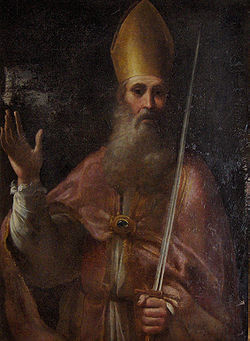Saint Romulus of Genoa | |
|---|---|
 Saint Romulus, cathedral of San Siro, Sanremo | |
| Bishop and Confessor | |
| Died | Sanremo, Liguria, Italy |
| Venerated in | Roman Catholic Church |
| Feast | November 6 (formerly October 13, December 22) |
| Attributes | depicted with episcopal dress and a sword in hand |
Romulus (or Remus) of Genoa (Italian : Romolo; Ligurian : Reumo(l)o) was an early Bishop of Genoa, around the time of Syrus. [1] His dates are uncertain: since Jacobus de Voragine [2] traditional lists compiled from local liturgies generally place his bishopric fourth in a largely legendary list. [3] He fled from Genoa and never returned [4] He died in the cave he inhabited at Villa Matutiae, [a] a town on the Italian Riviera which later adopted his name, becoming San Remo (from 15th century until the first half of the 20th century), and later Sanremo. [5]